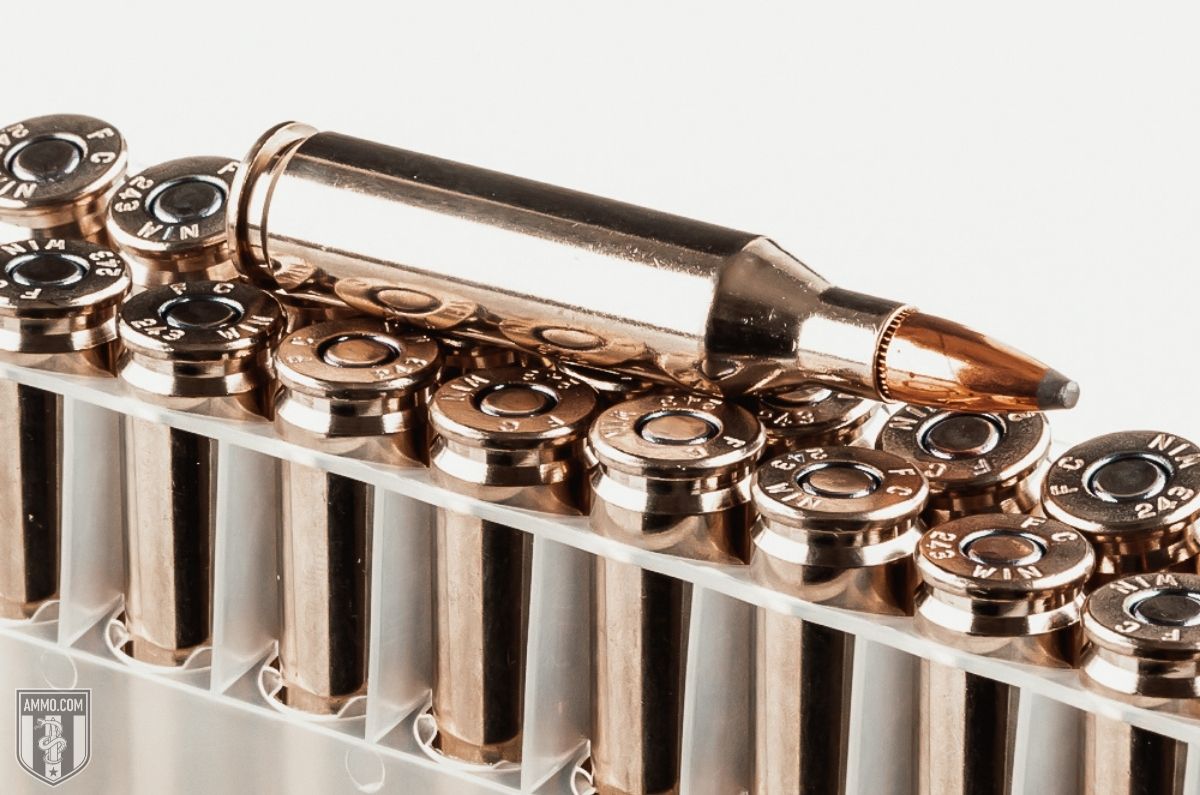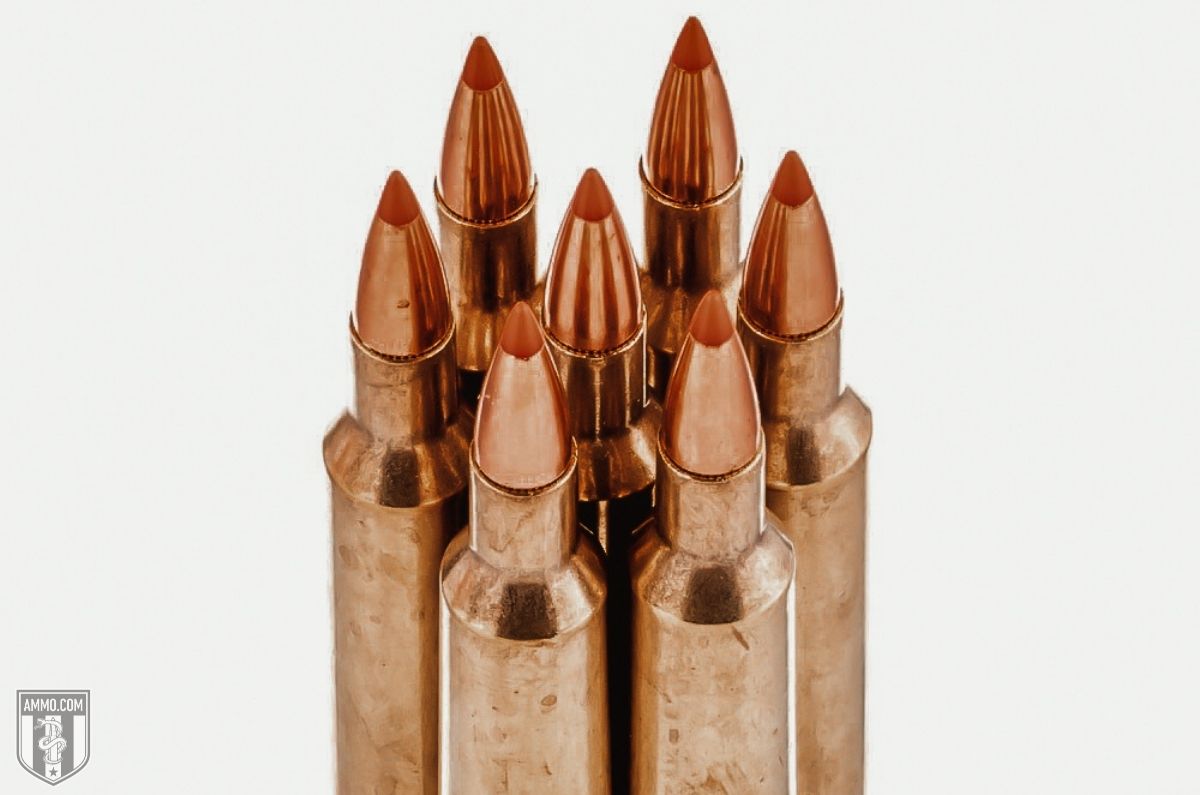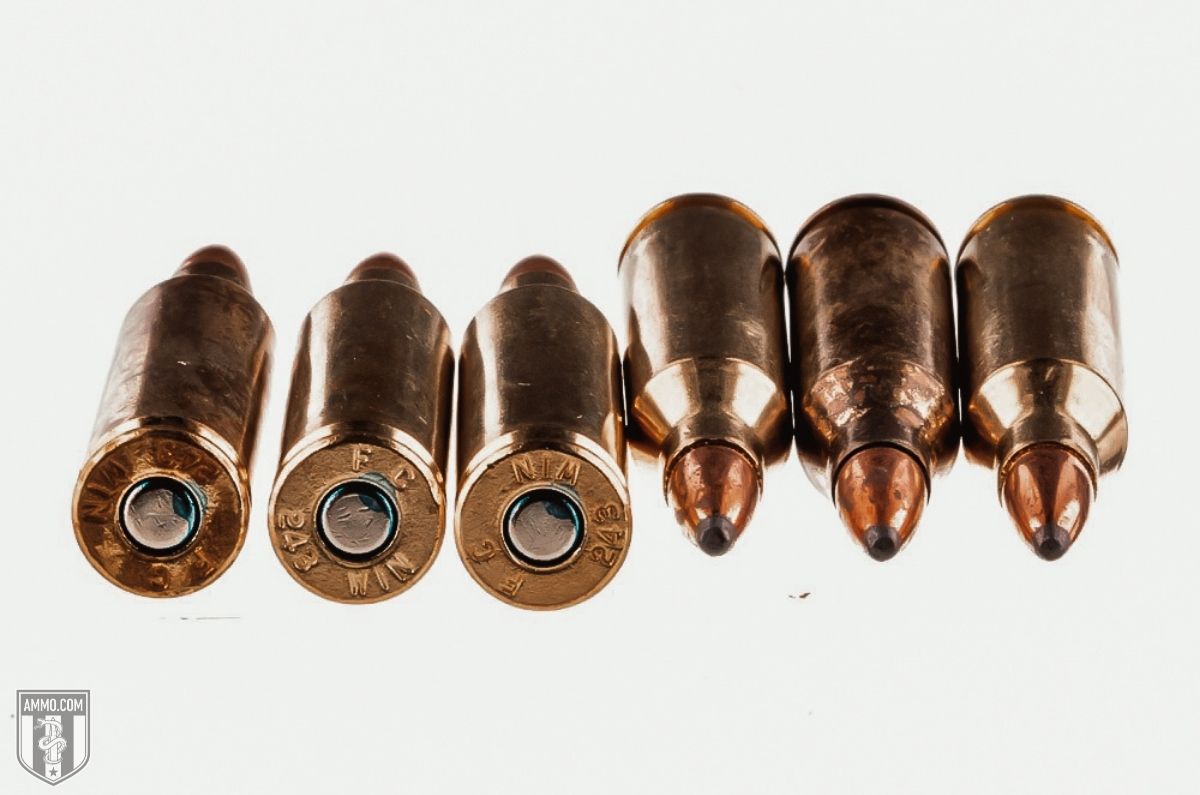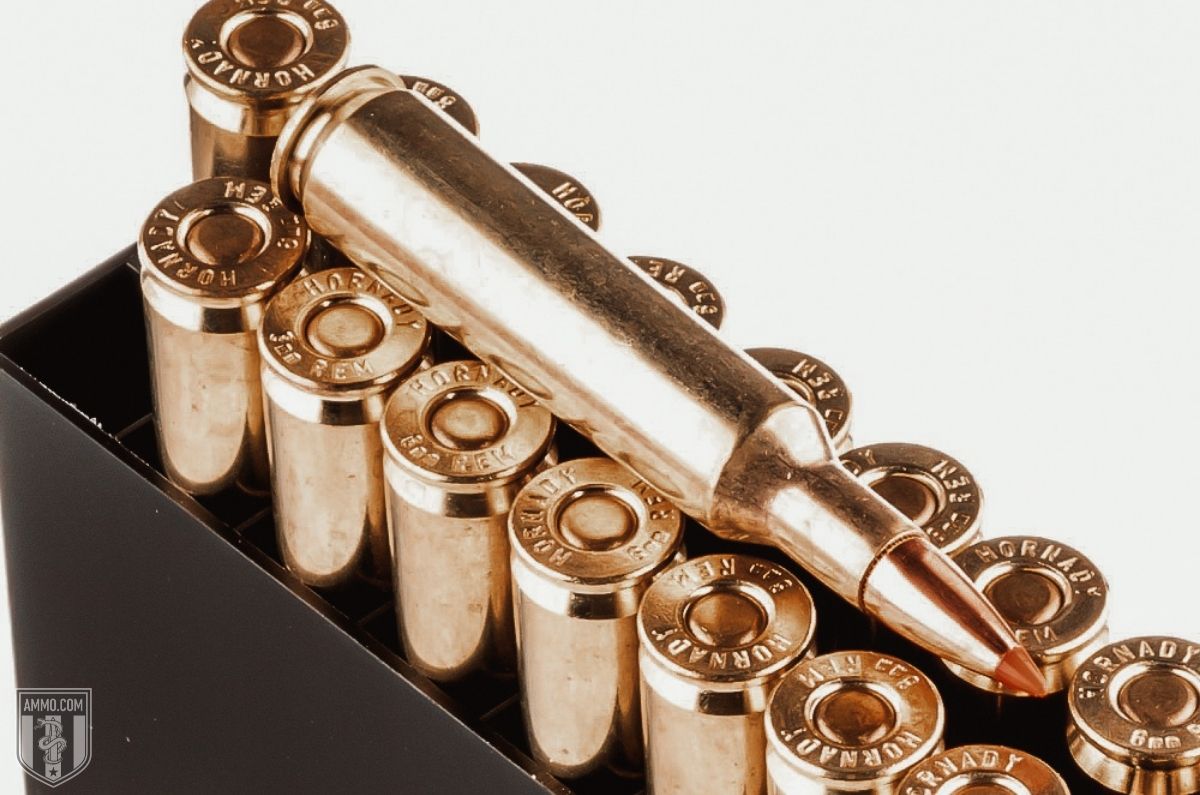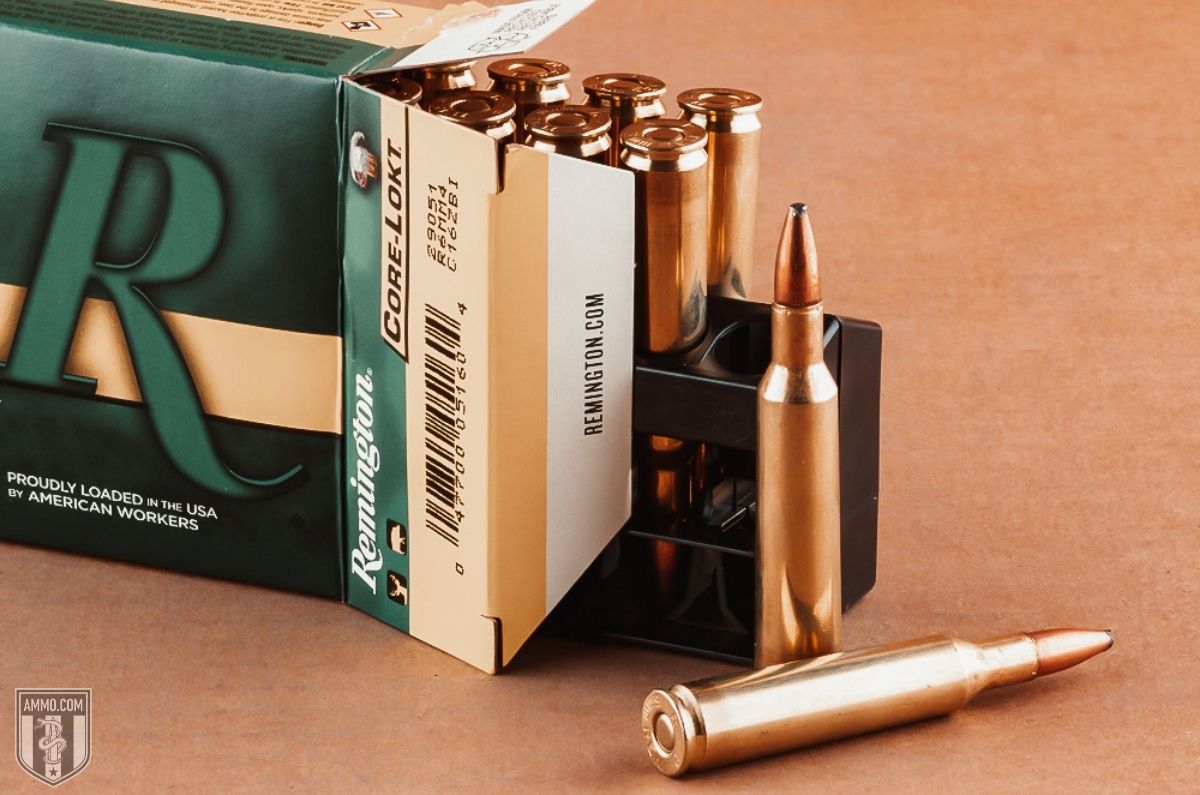6mm Remington vs 243: The Battle of the 6mm Cartridges
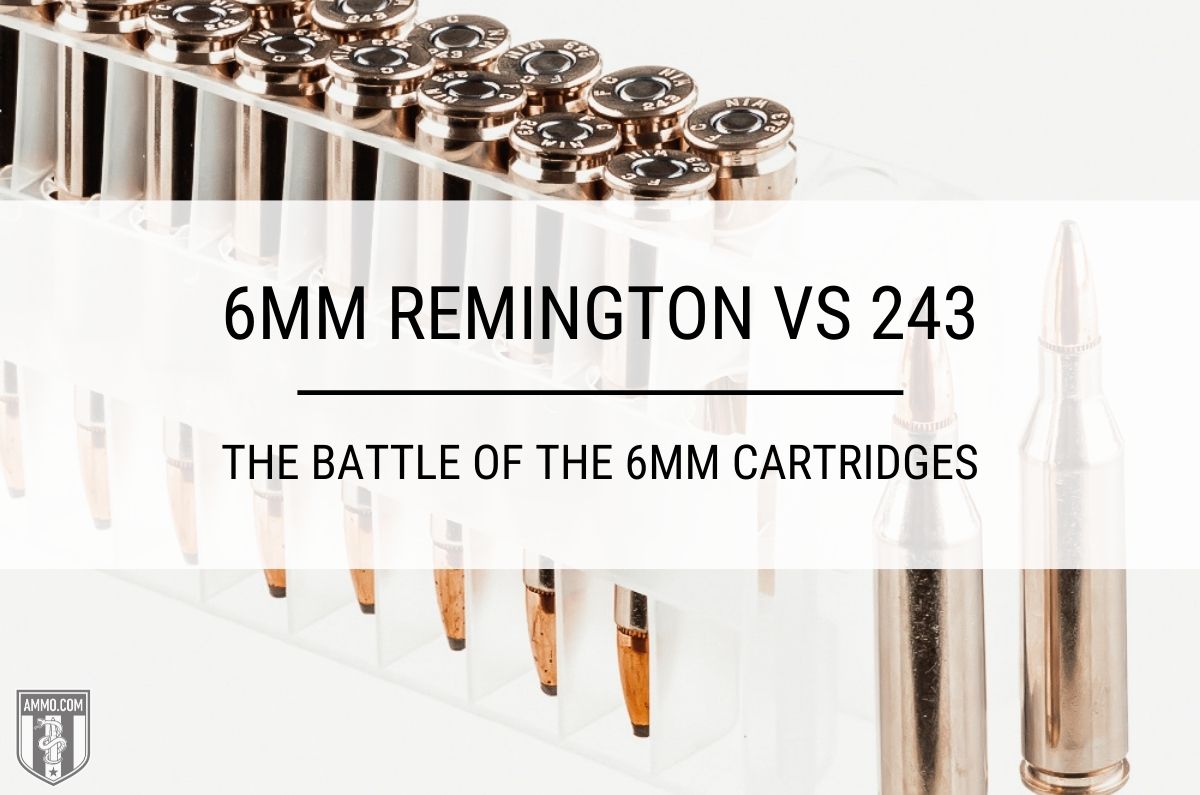
The 243 Winchester and 6mm Remington are two 6mm rifle cartridges that are extremely versatile, as they can pull double-duty as a varmint round as well as a potent deer hunting cartridge.
Despite firing the same 6mm diameter bullets, the 243 Win is a commercial success while the 6mm Rem remains somewhat of a fringe cartridge. Although the 243 is considered the gold standard when it comes to 6mm cartridges, the Remington offering has several minor advantages that make hunters question which cartridge is right for them.
In this article, we will evaluate the 6mm vs 243 to help you understand the differences between the two and give you a clearer idea of which cartridge is best for your shooting and big game hunting needs.
What is the difference between 243 and 6mm?
The difference between 243 and 6mm is that the 6mm Rem has a slightly larger case than the 243 Win. This allows for increased powder capacity as well as marginally improved ballistic performance.
The War of the 6mm Cartridges
Both the 243 Win and 6mm Rem were released in 1955, and although they both had similar ballistic performance, the 243 was a success while the 6mm was an abject failure. To understand why, it’s important to understand the psyche of the American shooter back in the 50’s.
Back in the day, versatility was favored over specialization. This meant that if you could have one rifle that was good for hunting whitetail, antelope, coyotes, and other varmints, it would be preferred over having multiple rifles. In today’s world, we have guns that are specialized for every shooting occasion, but back then, having one or two guns that covered all your bases was the mantra of the day.
This is the one area that Remington failed at during the launch of the 6mm Remington, which was known by a different name back then.
The 6mm Remington began its life as the 244 Remington, and in the 50’s the 6mm bore size had fallen out of favor with the shooting community. However, it was wildcat handloaders who brought the 6mm bullet back into the limelight.
The 243 Win was derived from another wildly successful hunting cartridge, the 308 Winchester. The 243 Win is simply a 308 case necked down to accept a 0.243” diameter bullet. As is common with wildly successful cartridge, the 308 Winchester sired multiple cartridges, but the 243 Win was the most popular of them all. Winchester chambered the new 243 Win in its Model 70 bolt-action rifle, Model 88 lever-action, and Model 100 autoloader with a 1:10 barrel twist rate.
In similar fashion, the 244 Remington was the brainchild of Fred Huntington, founder of RCBS. Huntington necked down a 257 Roberts cartridge, which itself was a necked down 7x57 Mauser, to accept a 0.243” bullet. Named the 243 Rock Chucker, Huntington’s wildcat cartridge was picked up by Remington and renamed the 244 Rem and chambered in their Model 722 bolt-action rifle with a 1:12 barrel twist rate.
Winchester released the 243 with the intention that it would be a varmint/predator hunting round as well as a whitetail cartridge. As such, they released an 80 grain varmint load and a deer load that fired a 100 grain bullet. On the other hand, Remington envisioned their round as a long range varmint round, and released 75 and 90 grain factory loads.
Gun writers of the day pulled no punches and swooned over the effectiveness of the 243 Win for deer hunting and pest control while the 244 Remington got very little press. The belief of the time was that the 244 Rem lacked the bullet weight for deer while the 100 grain bullet fired by the 243 was perfect.
There was also concern about the slower twist rate of the 244 Rem and its ability to stabilize heavier bullets. Although some of this may fall into the land of conjecture, the damage was done and the public perception of the 244 Remington had it languishing for many years.
In 1958 Remington tried to resolve the barrel twist rate issue by offering a 1:10 barrel for 244 Rem, but this did little to assuage the unjust shunning of the 244 Remington.
Remington tried to do a facelift for the 244 Rem in 1963, they renamed the cartridge the 6mm Remington and released the “new 6mm” with 80 and 100 grain loads in their new Remington Model 700 rifle. The Model 700 became the flagship Remington bolt-action rifle as it was adopted by police departments and the military as a long range precision rifle platform. However, the 6mm Remington simply never caught on like the 243 Winchester ammo and the 6mm remains a somewhat fringe cartridge to this day.
Cartridge Specs
When evaluating centerfire rifle cartridges, it’s a good idea to analyze the cartridge specs to gain more knowledge of each.
The 243 Winchester and 6mm Remington have more similarities than differences.
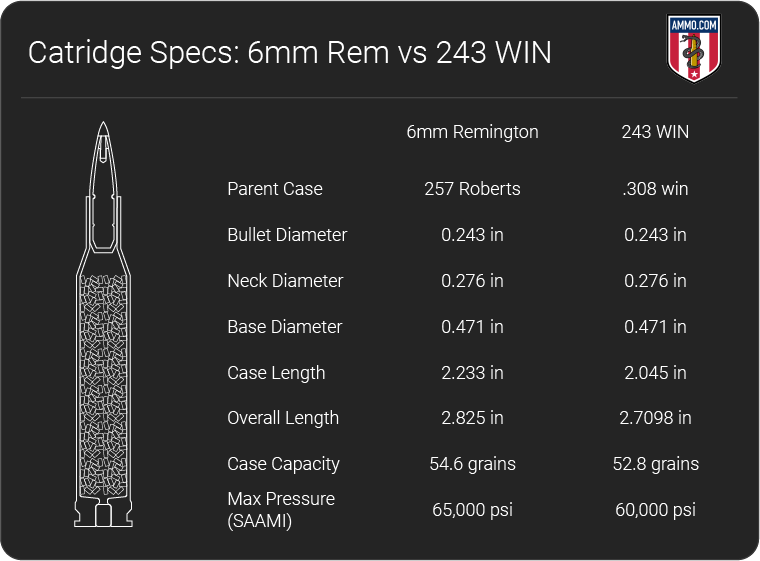
They both fire the same 0.243” diameter bullets and have identical neck and base dimensions.
The first major difference is the case length with the 6mm Rem being the longer of the two. The 243 has a case length of 2.045” while the 6mm Rem measures 2.233” long. This trend continues with overall length as the 243 has a maximum overall length of 2.7098” compared to 2.825” for the 6mm round. This puts both rounds firmly in a short action rifle, which is ideal for hunting as it is light weight and allows for faster follow up shots.
The added case length means that the case capacity of the 6mm Remington will be slightly higher than the 243. The 6mm has a powder capacity of 54.6 gr compared to 52.8 gr for the 243 Win. That may not sound like a huge difference, but it means that the Remington round will be able to fire their 6mm bullets at slightly higher velocities than the 243.
The final difference between these two rifle cartridges is their maximum chamber pressures. SAAMI specs indicate that the 6mm Remington can handle slightly higher pressures at 65,000 psi compared to 60,000 psi for the 243.
Recoil
Free recoil is virtually identical between 243 Winchester and 6mm Remington.
Recoil is an important consideration when purchasing a new rifle as a round with heavy recoil will be more difficult to control and will slow your rate of follow up shots.
Recoil is affected primarily by muzzle velocity (FPS), powder charge, bullet weight, and rifle weight.
The 243 and 6mm have nearly the same recoil, though the 6mm has slightly more.
For this example, we will compare two 100 grain bullets, as these are the most popular for deer hunting.
For the 6mm we will analyze the Remington Core-Lokt 100 grain soft point with a muzzle velocity of 3,100 fps and for the 243 Win the Federal Power-Shok 100 grain soft point traveling at 2,960 fps. The rifle weight for both rifles will be consistent at 7-pounds.
Given these criteria, the 6mm Rem will have a free recoil of 12.73 ft-lbs compared to 12.3 ft-lbs for the 243 Win.
Although the 243 Winchester technically has less recoil than the 6mm, the difference is so slight it is unlikely that most shooters will be able to feel a difference between these two rifle cartridges.
Muzzle Velocity, Kinetic Energy, and Trajectory
For this comparison, we will analyze three different factory loads for 243 and two for 6mm. The rounds selected for the 243 are the Sierra Prairie Enemy 70gr BlitzKing, the Hornady Precision Hunter 90 gr ELD-X, and the Nosler 100 gr Partition. For the 6mm, we will analyze the Hornady Superformance 95 gr SST and the Remington Core-Lokt 100 gr soft point ammo.
Other Homady 243 ammo is available if you want more options.
Looking at the data, you can see that the differences between 243 Winchester ballistics and 6mm ballistics are razor thin.
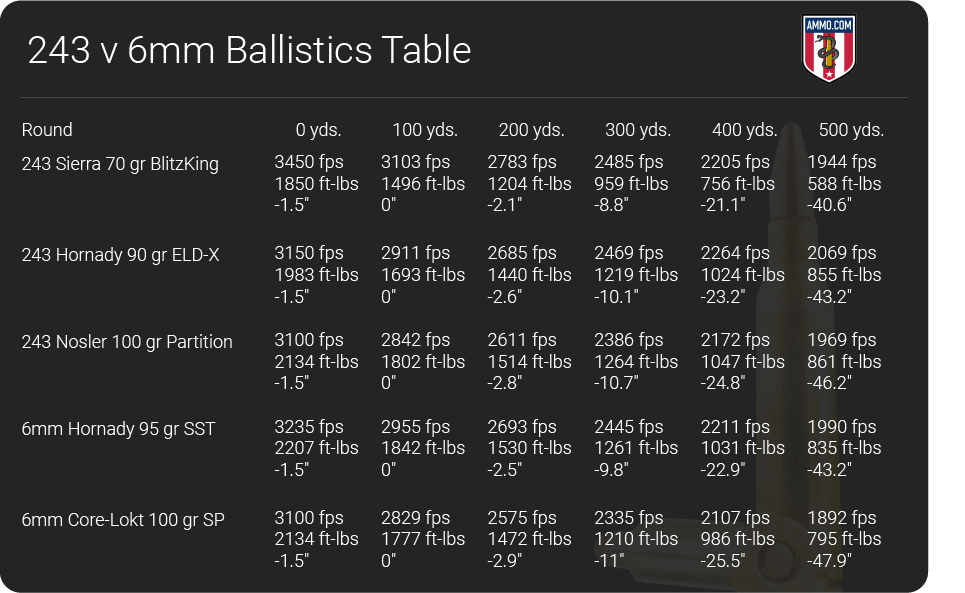
In terms of muzzle velocity, unsurprisingly the 70 gr Sierra bullet holds the top spot at 3,450 fps while the 6mm 95 gr SST comes in second at 3,235 fps. The other three factory loads are relatively close, hovering around 3,100 fps.
For muzzle energy, the 6mm 95 gr SST takes the top spot at 2,207 ft-lbs while the two 100 grain bullets leave the muzzle with 2,134 ft-lbs of energy. The 90 gr ELD-X and 70 gr Sierra BlitzKing for 243 both measure below 2,000 ft-lbs at the muzzle. It is interesting to note that the ELD-X and Nosler Partition for 243 and the 95 gr SST for 6mm all can maintain more than 1,000 ft-lbs at 400 yards, which is considered the lower limit of kinetic energy to harvest a whitetail.
In terms of trajectory, all five rounds are incredibly flat shooting thanks to their high muzzle velocities. The heavier bullets had the most bullet drop at 500 yards with -47.9” for the 100 gr Core-Lokt and -46.2” for the 100 gr Nosler Partition while the 70 gr Sierra BlitzKing had the flattest trajectory at -40.6”. All five rounds fall within 8-inches of each other at 500 yards, which is incredibly impressive to say the least.
Ballistic Coefficient and Sectional Density
As the 6mm Rem and 243 Win fire the same diameter bullets, there is essentially no difference in ballistic coefficient and sectional density between them.
Ballistic coefficient (BC) is a measure of how aerodynamic a bullet is and how well it will resist wind deflection. This means that a high BC bullet will resist wind drift better than a low BC bullet. Sectional density (SD) is a way to evaluate the penetration ability of a bullet based on its external dimensions, design, and weight.
As the 243 and 6mm can fire the exact same 6mm bullets, both cartridges will have the same BC provided they are firing identical bullets. Some bullets are more resistant to wind drift, like the Hornady ELD-X or a Sierra MatchKing, while other designs are more susceptible to wind drift like a jacketed soft point. However, so long as the two cartridges are firing the same bullet design, there should be no appreciable difference in BC.
On average, the heavier bullets between 90 and 100 grains for both cartridges will fall within a 0.35-0.40 range while the lighter bullets typically hover around 0.30 in terms of BC.
The same holds true for penetration and sectional density, as there will be no appreciable difference between the 243 Winchester vs 6mm as they fire identical bullets. Heavier loads typically have a SD around 0.23 while lighter varmint rounds have a SD hovering around 0.19.
Hunting
Although much has been written and said about the 6mm vs 243 in terms of big game and varmint hunting, the truth is that both are exceptional hunting cartridges.
A hunting rifle chambered in either 243 Win or 6mm Rem offers shooters the versatility to take on varmints like woodchucks, coyotes, and prairie dogs while still having the kinetic energy to take down pronghorn, antelope, and deer.
The success of both rifle cartridges hinges on the fact that most North American hunters will not take on anything larger than a whitetail deer during their hunting career. As such, the 6mm bullet is more than capable of taking down deer but is ill-suited for larger game like elk and moose. For these large game animals, something more powerful like a 30-06 Springfield would be preferred.
You cannot go wrong with either the 243 Winchester or 6mm Remington if you plan to primarily focus on varmint and deer hunting.
Ammo and Rifle Cost/Availability
Although the 243 and 6mm might be nigh identical in terms of their hunting prowess, the 243 Winchester outstrips the 6mm Rem in terms of ammo and rifle availability.
Due to its widespread commercial success, the 243 Win has considerably more factory ammo options available than the 6mm Rem to the tune of nearly a 10:1 advantage for the 243.
Ammo for the 243 is also considerably less expensive than the 6mm, as inexpensive 243 hunting ammo typically goes for around $1.30/round at the time of writing. On the other hand, 6mm Remington factory ammo goes for no less than $2.30/round.
The 243 Win also has considerably more rifle options available to it compared to the 6mm Remington. Virtually every rifle manufacturer, like Savage, Weatherby, Browning, Ruger, Remington, and Winchester has a bolt-action rifle chambered in 243 Win. Even low-cost bolt actions are available in 243, like the Savage Axis and Ruger American, that offer new hunters an inexpensive option to get into the sport.
As it stands today, the only major manufacturer who is offering factory new rifles for 6mm Rem is Remington, itself. In the past, Savage, Ruger, and Marlin have chambered rifles in 6mm Remington, but these lines have since been discontinued. It is possible to pick up an older Ruger No. 1 or M77 Hawkeye on the secondary market chambered in 6mm Rem, but otherwise you are restricted to Remington rifles only.
Reloading
If you like to handload your own ammo, both cartridges offer you a lot of options for customization in terms of projectiles and powders to make the perfect sub-MOA reloads for your varmint hunting rifle.
A 6mm rifle offers handloaders a lot of different options to perfect the perfect reload. From incredibly low bullet weights for varmints to heavier bullets for deer hunting, the 6mm sits right in the sweet spot that handloaders can leverage to make the perfect cartridge for all their shooting needs.
Reloading is where the 6mm/244 Remington really shines, as a handloader can tailor their bullets specifically to their rifle and are not constrained by factory loads. This works around the major complaints of earlier 244 Remington rifles and the slower twist rate, as you can handload 6mm bullets that your rifle likes the best.
Furthermore, the higher case capacity of the 6mm Rem offers a bit more flexibility to handloaders than the 243. Even though the 244/6mm Rem are dying a slow cartridge death, there is still plenty of load data available for those shooters who love their older cartridges.
Final Shots: 243 vs 6mm
The 6mm Remington and 243 Winchester are two centerfire rifle cartridges that excel at varmint and deer hunting, as well as long range target shooting.
The 243 Winchester is by far the more popular cartridge and has been the gold standard for the 6mm bullet diameter since its introduction in 1955. It has been a staple in the deer hunting community and has numerous rifles and factory ammo options available at most major retailers.
The 6mm Remington is a cartridge that never really took off in the commercial sense. Due to poor design and marketing decisions, the 6mm never really got to see the light of day despite having a minor advantage over the 243 Win in terms of powder capacity and slightly higher velocities.
Most shooters will go with the tried-and-true 243 Winchester, as rifles and ammo are easy to come by in all different varieties and configurations.
New 6mm cartridges like the 6mm Creedmoor and 243 WSM have handicapped the 6mm Remington’s acceptance and it seems to be doomed to eventual obsolescence. However, if you own an old 244/6mm rifle and like to handload, there’s no reason to sell it as you have all the flexibility that the 0.243” bullet diameter has to offer at your fingertips.
No matter which cartridge you choose, make sure you stock up on ammunition here at Ammo.com and I’ll see you on the range!
Ammo Comparisons
- .308 vs 5.56
- 6.5 Creedmoor vs .308
- .300 Blackout vs .308
- .300 Win Mag vs .308
- .243 vs .308
- .308 vs .30-06
- 7mm-08 vs .308
- .270 vs .308
- 7.62x39 vs .308
- .223 vs .308
- .338 Lapua vs .308
- .380 ACP vs 9mm
- .223 vs 5.56
- .300 Blackout vs 5.56
- 9mm vs 45 ACP
- 9mm vs 40 S&W
- .357 SIG vs 9mm
- 10mm vs 9mm
- 9mm vs 9mm Luger
- .243 vs .270
- .300 Win Mag vs .30-06
- .270 vs .30-06
- .40 vs .45
- 38 Special vs 357
- 9mm vs 40 vs 45
- 5.56 vs 7.62x39
- 338 Lapua vs .30-06
- .30-30 vs .30-06
- 300 PRC vs 338 Lapua
- .30-06 vs 7mm
- 300 Win Mag vs 338 Lapua
- 300 PRC vs 300 Win Mag
- 300 WSM vs 300 Win Mag
- 338 Win Mag vs 338 Lapua
- 12 Gauge vs 20 Gauge
- 10mm vs 357 Mag
- .30-30 vs 7.62x39
- 224 Valkyrie vs 22-250
- 17 HMR vs 22 Mag
- 7.62x39 vs .300 Blackout
- 45 ACP vs 45 Auto
- 45-70 vs 30-30
- 300 Blackout vs 223
- 357 Magnum vs 9mm
- 350 Legend vs 300 Blackout
- 224 Valkyrie vs 223
- 45 ACP vs 38 Super
- 6.5 Grendel vs .308
- 17 HMR vs 22 LR
- 10 Gauge vs 12 Gauge
- 22-250 vs 223
- 45 Colt vs 45 ACP
- 350 Legend vs 30-30
- 5.7x28 vs 223
- 5.7 vs 9mm
- 5.56 vs 5.7
- 22 vs 9mm
- Buckshot vs Birdshot
- 450 Bushmaster vs 308
- 450 Bushmaster vs 223
- Buckshot vs Slug
- 6.5 Grendel vs 5.56 vs 223
- 6mm ARC vs 6.5 Grendel
- 44 vs 45
- 458 SOCOM vs 5.56
- 357 vs 44
- 32 ACP vs 380
- 300 Win Mag vs 338 Win Mag vs 338 Lapua Mag
- 450 Bushmaster vs 458 SOCOM vs 50 Beowulf
- 6mm Creedmoor vs 6.5 Creedmoor
- TMJ vs FMJ
- 44 Special Vs 44 Magnum
- 45 90 vs 45 70
- 6.8 Western vs 6.8 SPC
- 50 Beowulf vs 50 BMG
- 26 Nosler vs 6.5 PRC
- 28 Gauge vs 410
- 6.8 SPC vs 5.56
- 6.8 SPC vs 6.5 Grendel
- 6.8 Western vs 7mm Rem Mag vs .28 Nosler
- 6.8 Western vs 6.5 Creedmoor
- 22 Hornet vs 223
- 6.8 Western vs 6.5 PRC
- .410 vs 12 Gauge
- .410 vs 20 Gauge
- 22 LR vs 22 Mag
- 6mm ARC vs 243
- 7mm-08 vs 270
- 243 vs 6.5 Creedmoor
- Nickel vs Brass Casing
- 204 Ruger vs 223
- 50 Beowulf vs 5.56
- 260 Remington vs 6.5 Creedmoor
- 6mm Remington vs 243
- 28 Nosler vs 300 PRC
- 50 Beowulf vs 50 AE
- 22 Nosler vs 22-250
- 450 Marlin vs 45-70
- 300 Win Mag vs 300 Norma
- 458 SOCOM vs 300 Blackout
- 38-55 vs 45-70
- 22 Hornet vs 22 LR
- 300 Norma vs 338 Lapua
- 338 Lapua vs 50 BMG
- 28 Nosler vs 300 Win Mag
- 28 Nosler vs 6.5 Creedmoor
- 204 vs 22-250
- 458 SOCOM vs 45 70
- 44 40 vs 45 70
- 6.8 SPC vs 6.5 Creedmoor
- 450 Bushmaster vs 30-06
- 7mm Rem Mag vs 300 Win Mag
- 30 Carbine vs 223
- 25-06 vs 30-06
- 26 Nosler vs 28 Nosler
- 16ga vs 12ga
- 30 06 vs 7.62 x54R
- 9mm Makarov vs 9mm Luger
- 350 Legend vs 223
- 30 Carbine vs 5.56
- 6.5x55 vs 6.5 Creedmoor
- 6.5 Creedmoor vs 270 vs 25-06
- M193 vs M855
- 450 Bushmaster vs 458 SOCOM
- 6.5 Grendel vs 6.5 Creedmoor
- 350 Legend vs 5.56
- .277 Fury vs 6.8 SPC
- 277 Fury vs 300 Win Mag
- 10mm vs .45 ACP
- 277 Fury vs 223
- 6.8 SPC vs 300 Blackout
- 6.5 PRC vs 6.5 Creedmoor
- 277 Fury vs 308
- 277 Fury vs 6.5 Creedmoor
- 350 Legend vs 450 Bushmaster
- 277 Fury Vs 5.56 NATO
- 10mm vs 40S&W
- 32 ACP vs 9mm
- 32 Special vs 9mm
- 8.6 Blackout vs 300 Blackout
- 30 Super Carry vs. 9mm
- 5.56 vs 9mm
- .50 Action Express vs 9mm
- 7.62x25 vs. 9mm
- 10mm vs 44 Magnum
- 300 Blackout vs 300 Win Mag
- 6.5 Grendel vs 300 Blackout
- 460 Rowland vs 10mm
- 300 RUM vs 300 PRC
- 300 Norma vs 300 PRC
- 45 GAP vs 45 ACP
- 7mm PRC vs 300 Win Mag
- 300 PRC vs 6.5 Creedmoor
- 300 PRC vs 308
- 357 SIG vs 357 Mag
- 7.62x39 vs 7.62x51
- 243 Win vs 223 Rem
- 30 Nosler vs 300 PRC
- 6.5 Creedmoor vs. 30-06 Springfield
- 450 S&W vs. 44 Magnum
- 6.5 Creedmoor vs. 300 Win Mag
- 454 Cassull vs. 45-70 Govt
- 454 Cassull vs. 44 Mag
- 7.62x54r vs. 308 Winchester
- 22 ARC vs. 223 Rem
- Subsonic vs. Supersonic Ammo

